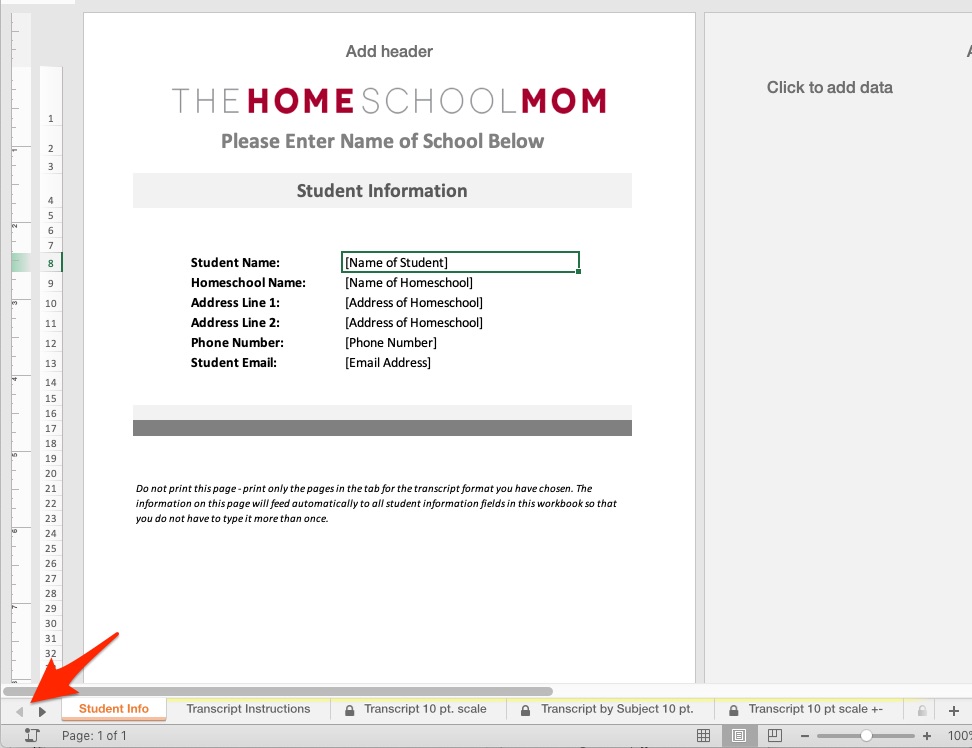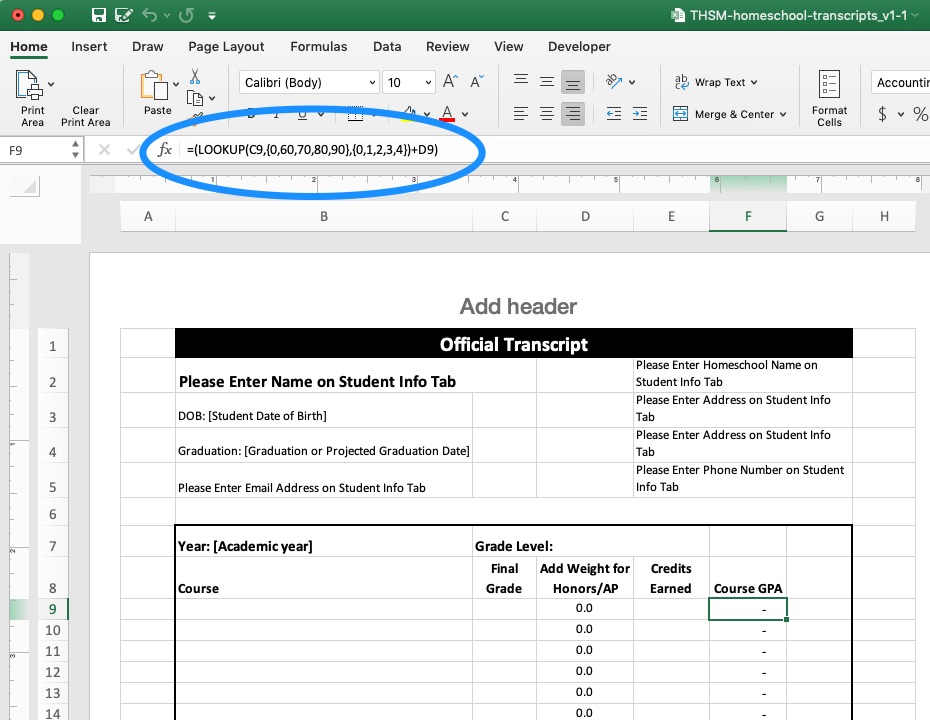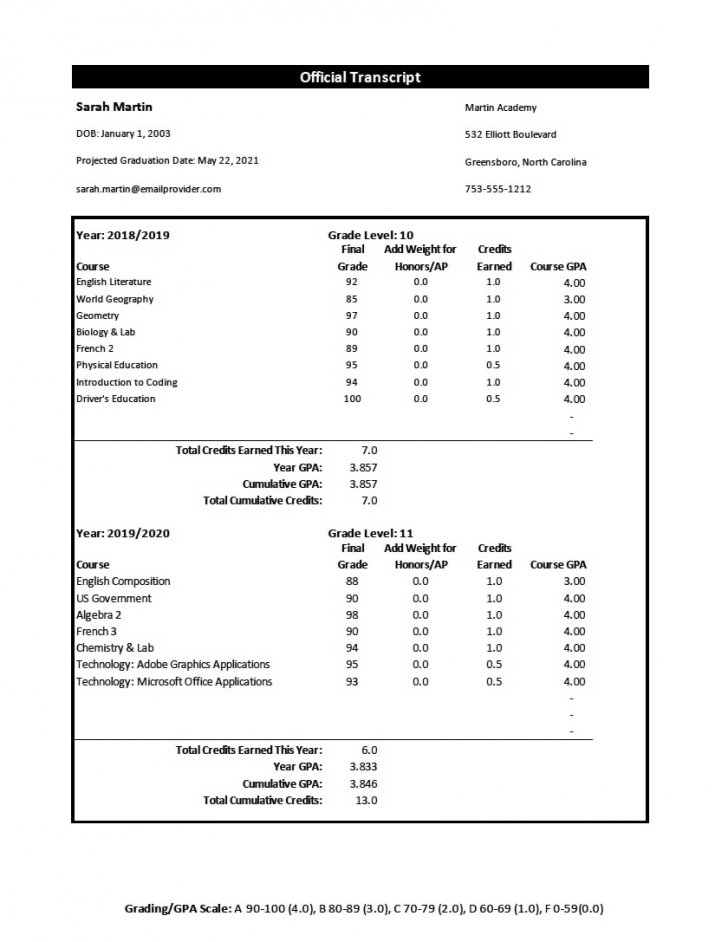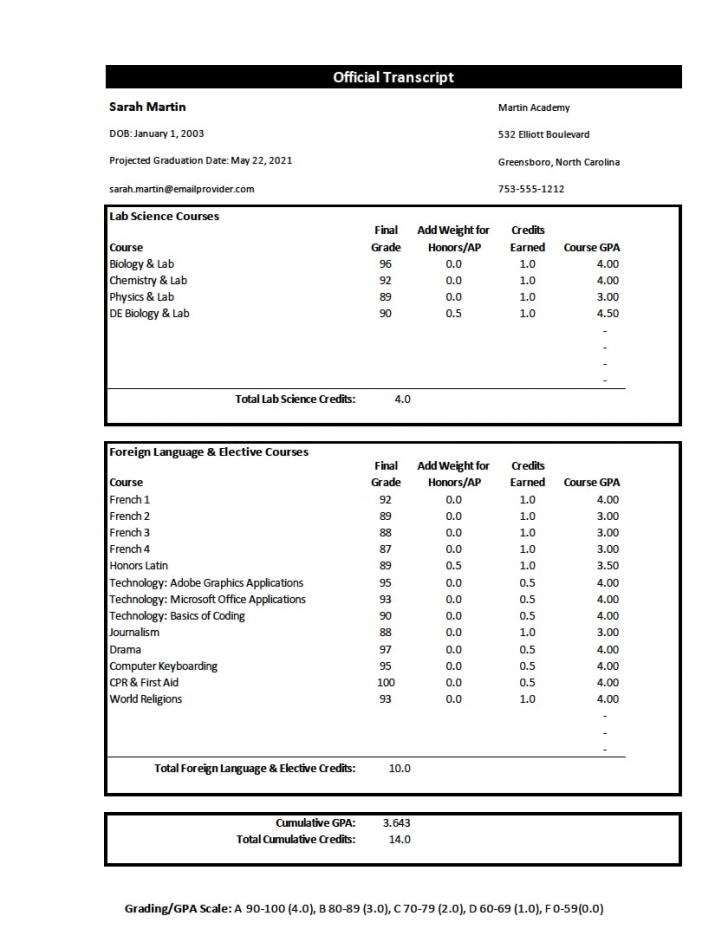(With Free Homeschool Transcript Templates)
One of the things that intimidates people the most about homeschooling high school is how to make homeschool transcripts. Thankfully, the solution is much easier than homeschoolers expect it to be, and it's free-you don't need a homeschool transcript service or expensive record-keeping software in order to create a homeschool transcript for high school to send to colleges. If you are intimidated by the whole college admissions process, before reading about creating homeschool transcripts you might want to read Jeanne's article about college admission requirements for homeschoolers.
This homeschool transcript template is offered in good faith at no cost, but you are responsible for checking the accuracy of all information in the completed transcript, including GPA calculations. TheHomeSchoolMom is not responsible for any potential errors, including the formulas and/or resulting GPA calculations. Use at your own risk.

We often receive questions about homeschool diplomas, but it's important to understand that when colleges ask for student records, they are asking for high school transcripts-the student's official academic record.
There are several ways to produce homeschool transcripts for your student, including availability from various organizations, online planner services, or creating your own. We have made it easy to print your own transcripts with our free homeschool transcript template for Excel-just input the information, set the print area, and print the spreadsheet.
Homeschool Transcript FAQ:
- What is the purpose of a transcript?
- What is the best way to keep track of records/grades for high school?
- What goes on a homeschool high school transcript?
- How many high school credits are needed to graduate?
- Which courses should be included on a homeschool transcript?
- Do courses have to be accredited/do the transcripts have to come from an accredited institution?
- If we covered AP material, can I count the course as an AP course?
- Is there a special format and/or contents needed for homeschool transcripts sent to colleges?
What is the purpose of a transcript?
Homeschoolers have many experiences and activities that they want admissions officers to notice, but care should be taken to promote those in the appropriate manner. This may or may not be on a homeschool high school transcript. As the student's official academic record, a high school transcript is shared with colleges and universities to show the student's academic readiness to do work at the college level.
While homeschoolers often think of homeschool transcripts as the place to help their student stand out in a crowd of applicants, college admissions officers may have a different purpose for transcripts. The admissions personnel with whom we spoke look to the application itself to see the individuality of the applicant, while transcripts were strictly used to verify that the base admission criteria for the college or university have been met.
Some schools are moving to a SRAR (self-reported academic record) in which the student enters their courses and grades in an online form as part of the college application. If the student is offered admission, a final official transcript is required to verify the self-reported information. In this case, it is important to make sure that the information in the transcript matches the SRAR, but it is also important to realize that the school will not see the transcript until after an offer of admission has been made.
What is the best way to keep track of records/grades for high school?
The best method is the one that YOU will use, because done is better than perfect. You may even wish to have your student keep the records.
No matter which record-keeping method you choose, it is a good idea to save everything your homeschooler is doing from about 8th grade on. Optimally, you will have some kind of written overview of the material covered and activities completed, including keeping the paperwork and any files from each class should you need them (larger projects can be photographed or videoed and filed digitally) as a reference. Beyond that, you can keep records either in a printed homeschool planner, a digital homeschool planner (online service, software, or spreadsheet), or simply keep a notebook with written notes.
Delight-directed or interest-led homeschooling does not mean transcripts have to be difficult. Vanessa Wright has suggestions for assigning credits for non-traditional learners. Unschoolers can keep track of learning using our unschooling record keeper, included in our printable homeschool planner.
When the time comes to create homeschool high school transcripts, your record-keeping should make it a simple process to enter the needed information (detailed below) into the transcript form/template. It is easiest if you keep up with the courses and grades as you go rather than waiting until you need to submit a transcript to start working on it.
What goes on a homeschool high school transcript?
While we may think of homeschool transcripts as record-keeping on our part, it's important to keep in mind that a transcript's main job is to communicate the student's readiness for college by proving that they have completed all of the requirements for admission. As such, a homeschool transcript should include course names that are as descriptive as possible and that appropriately reflect the difficulty level of the work.
Student information
A homeschool transcript should include:
- Student's name
- Your homeschool name (see "Should You Name Your Homeschool?")
- Your homeschool address (usually your home)
- Your phone number
- Student's date of birth
- Graduation date (use projected graduation date for pre-graduation submissions)
- A section for each grade OR a section for each subject area in which high school courses were completed, with the information below included for each individual course
- Number of credits (both cumulative and, if organized by year, for each year)
- GPA (both cumulative and, if organized by year, for each year)
- Grading scale
Course information
For each course on your transcripts, you should include:
- Course name
- Grade earned for each course
- Course weight (if additional weight is given) for each course
- Number of credits for each course
- GPA for each course
Other homeschool transcript considerations
Course descriptions. You may wish to also keep a course description for each course in your personal records (this won't be needed on the transcript), and you may even want to submit this with the homeschool transcripts. Some colleges find course descriptions helpful; if you decide to include them with your transcript submission, be sure they are no more than one page. Whether or not to include them is an area you may wish to ask for guidance from the admissions office of the school to which your child is applying-giving them more than they want to see can actually be detrimental.
Format. Students who have taken longer than usual to complete high school courses may find it beneficial to list courses by subject rather than by grade. The same information is shared but in a way that de-emphasizes the number of years in which the courses were completed. On the other hand, if a student is weak in a specific area it can be de-emphasized by grouping the courses by grade.
Outside evidence. You may wish to include information about where your child took specific courses, either on the transcript or a supplemental submission. While colleges accept homeschool transcripts, showing them outside evidence of the student's work helps colleges to see that a variety of professionals have worked with the student and evaluated their work. Jeanne has written extensively about outside evidence for college admissions, including sources for obtaining outside evidence.
Outside evidence may not all fit appropriately on a transcript. Some may be in the application, some may be included as references, and some might be submitted as test scores. Forecasting (during the early planning stages for high school) the content of the student's final transcripts (and applications as a whole) will help to illuminate gaps that need to be filled. You might find our high school course planner (part of Homeschool Planner Plus) helpful, and Jeanne has written previously about teaching subjects where Mom's not the expert, which is useful in the planning stages for high school.
Social Security number. Some homeschoolers include the student's social security number on the transcripts, but this is generally not necessary (or even advisable, since it can introduce the possibility of identity theft). You may wish to state "SSN available upon request" if you are concerned that the school might want to see the SSN. An alternative identification is to include the ID number from the student's Common Application submission on the transcript.
How do I make a transcript for my unschooler/non-traditional learner?
Often the learning experiences of non-traditional learners don't fit neatly into a traditional transcript format. Not a problem! Just as non-traditional homeschoolers think outside of the box for learning, they can put together a transcript with the same kind of thinking. Check out Vanessa's "Tips for Assigning High School Credits for Your Non-Traditional Teen Learner or Unschooler" for how to create a great transcript for your student.
How many high school credits are needed to graduate?
In most states, you decide how many credits your student needs to graduate. At the time of this publication, no state requires homeschoolers in the US to follow public school requirements for graduation, but a few states do have graduation requirements for homeschoolers in their homeschool statutes. Be sure to know the homeschool law in your state regarding graduation requirements, if any.
Even if you are in a state where you get to decide the number of credits needed for graduation, it can be helpful to know what colleges are seeing on transcripts for the public school students with whom the homeschooled student is competing. You can find the course and credit requirements for graduation for each state and territory in the US on the website of the Education Commission for the States.
Homeschoolers should also be aware that their state may have other requirements related to high school that affect college graduation. An example of this is New York's "preliminary education requirements," which do not prevent homeschoolers from graduating from high school or enrolling in college, but are required in some form before a student can graduate from college. Since at least one of the options must be completed while the student is still of compulsory school age, it is imperative that homeschoolers know the education laws of their state and of any state where they may wish to attend college.
Which courses should be included on a homeschool transcript?
Math starting with Algebra I (or Geometry if your student takes that before Algebra), high school level foreign languages, and high school level sciences are all included no matter when they are taken. Typically, these courses are first taken around 8th grade, but of course this varies by individual. All other courses taken from 9th-12th grade should be included as well.
Every college has different high school course requirements, so check to see what the individual colleges to which your student is applying require. If you have no idea which school your child might attend, you can find a general list of requirements on the College Board website. Requirements also vary by program, so whether your student is going into arts (BA) or sciences (BS) will make a difference in requirements. Typically, a high school transcript will include something similar to the following:
- 4 years of English including literature and writing
- 4 years of math including a minimum of Algebra I, Algebra II, Geometry, and Trigonometry
- 2-4 years of social sciences, such as World History, World Geography, US History, and US Government
- 2-3 years of lab sciences, such as Biology, Chemistry, and Physics
- 2+ years of the same foreign language (some colleges give credit for ASL as a foreign language and some do not)
- electives for the balance
Be sure that your student covers the material that is expected by the institutions to which they will apply. If your student doesn't yet know what they want to do after high school, it is a good idea to examine the requirements of a variety of institutions so that you can plan for all of the options. Most schools have a page listing the high school requirements (like this one for Virginia Tech) for applicants, but requirements may be different for specific colleges/degree programs within each university.
Do courses have to be accredited/do the transcripts have to come from an accredited institution?
In almost all cases, neither courses nor institutions need to be accredited for a course to be put on a high school transcript. Notable exceptions are if a student is interested in playing NCAA sports (high school programs must be approved by the NCAA), or if a student is planning to go from homeschooling to a public or private high school, which have their own restrictions about what can be transferred in. You can read more about accreditation in our article about homeschool accreditation and in Jeanne's article about homeschool diplomas.
If we covered AP® material, can I list the course as an AP® course?
AP® is a registered trademark of the College Board, and a course can only be listed on a homeschool transcript as an AP course if the instructor and materials "go through a process called the AP Course Audit, which ensures that each AP course meets specific standards..." and is approved by the College Board as an AP course for the year in which the audit was done. Homeschool teachers can be approved to teach AP® classes by going through the course audit process before the course is taught.
A less restrictive option is to designate a course using AP® material as an honors course. Honors courses earn that designation through the use of advanced material and homeschoolers should be diligent to use the term only when appropriate.
Dual enrollment courses (usually taught at a community college or through a local high school) are another option. Dual enrollment courses are those for which a student earns both high school and college credit at the same time.
Typically more weight is given for AP, honors, and DE courses on the transcript, but not always-Lee Binz of The Home Scholar never weights classes on transcripts. And keep in mind that just because a course is designated as DE doesn't mean that the student will be awarded college credit for it.
As with determining the number of credits required for graduation, remember that it is your school, and you decide.
Is there a special format and/or contents needed for homeschool transcripts sent to colleges?
Transcripts you send to colleges should:
- State that they are official transcripts (and if they are final, state that as well)
- Show the grade point average based on grades and weighted credits (this is automatically calculated in our free homeschool transcript spreadsheet template)
- Be free of spelling/grammar errors
- Be printed on good quality paper (you don't need to spend a fortune, but avoid the lowest grade paper)
- Be signed either at the top of the first page or the bottom of the last page by the school administrator (you!)
- Be in a sealed envelope with a signature across the seal and submitted via USPS
If you have any issues, you may wish to offer a notarized copy of the transcripts, although this should not be necessary.
Free Homeschool Transcript Template
Homeschool Planner Plus formerly included an older version of our transcript template, but we have revised and updated the transcript and made it available as a separate file. The revised and separate homeschool transcript workbook for Excel has options for creating a transcript either by year or by subject, and includes both 10 point scale and 10 point scale with +/- options.
For questions, see the FAQ & Troubleshooting section below. At this time, we are only offering the updated homeschool transcript template for Excel and not other spreadsheet programs. Simply choose the style you prefer and enter the courses with the grades. For courses that should be weighted (honors courses, for example), simply add the extra weight in the indicated column and it will be figured into the final GPA.
This homeschool transcript template is offered in good faith at no cost, but you are responsible for checking the accuracy of all information in the completed transcript, including GPA calculations. TheHomeSchoolMom is not responsible for any potential errors, including the formulas and/or resulting GPA calculations. Use at your own risk.
How To Use the Transcript Template
Instructions on how to navigate and add information to the subscriber-exclusive homeschool transcript template.
Troubleshooting/Customizing FAQ for the Homeschool Transcripts
- I'd like to make changes and the sheet is locked. What is the password to unlock it?
- I can't enter my student's info at the top of the transcripts because the sheet is protected.
- I can't find the Student Info tab (or another tab). Why is it missing?
- What is the difference between the 10pt. +/- scale and the 10 pt. scale?
- Can I change the grading scale?
- I can't set the print area.
- When I print the transcript the grid lines are all on the transcript. How do I get them to not print?
- Can I use the transcripts in Google Sheets?
- How can I add a row so I can insert another course?
I'd like to make changes and the sheet is locked. What is the password to unlock it?
The spreadsheet is locked to avoid changes that might affect the GPA and credit calculations. If you are experienced with Excel and wish to unlock the tabs, you can do so with the password letmein. Each tab must be unlocked separately. I highly recommend checking the calculations manually after making any changes to ensure that they are correct.
I can't enter my student's info at the top of the transcripts because the sheet is protected.
All of the student information is entered on the very first tab (Student Info) and feeds automatically to the other tabs. The Student Info Tab is unlocked.
I can't find the Student Info tab (or another tab). Why is it missing?
There are directional arrows at the bottom left (the location of the arrows may be different in your spreadsheet program) that allow you to scroll through the tabs if they aren't all on the screen. If you don't see the Student Info tab, you need to use the left pointing arrow to scroll back to it. Screenshot of the tab and arrows:

What is the difference between the 10pt. +/- scale and the 10 pt. scale?
Some schools uses a +/- system when grading (B+, A-, etc.) and others simply use a straight A-F system without any +/- assignments. It's entirely your preference the way you wish to grade your students.
Whichever scale you choose, the template for that system will use the correct grade points to figure the GPA. You'll see the grade point assignment scales at the bottom of each template, so you can tell what grade point is assigned to that letter grade, whether it be a straight A-F system or a +/- system.
Can I change the grading scale?
The scale needs to be changed in the formula in order for the GPA to reflect your preferred scale. You'll find the formula by unlocking the sheet with your preferred scale (straight A-F or A-F with +/-) and clicking on each cell in the F column beside the courses entered. You should be able to choose one cell to correct, then copy and paste it into the other rows (the relative cells will change for each row, so if you copy the code from row 9 and paste to row 10, the references to C9 and D9 will change to C10 and D10). The formula looks like this for the A-F scale:

Where you see "0,60,70,80,90" in the cell, that is the ranges for the grades. 90+ is a 4.0, 80 - 89 is a 3.0, etc. The +/- scale has more numbers to account for the additional point values assigned for the +/- grades. You can change the number to indicated the lowest grade for each grade point range. You will need to edit the footer to match your new grade range. To edit the footer, click on the View ribbon and choose Page Layout. Click the center cell in the footer to edit the footer text.
One thing to note about this is that typically colleges do not rely on grade-based GPA as much as the number grade because schools have varying scales, so it may not be worth changing the scale. It's entirely your choice, but many colleges will average out the GPA based on their preferred scale regardless of what is on the transcript so that students are on equal footing.
I can't set the print area.
If you are sending in physical copies of the transcript, there is no need to set the print area (which you can't do without unlocking the sheet). It will print correctly as is, but it will add pages on the end for the area that says "do not print the content below."
All you have to do is visually check how many pages the actual transcript will be (should match the way the page breaks are set up visually and it prints top to bottom, then goes over to the pages on the right that you don't want to print) and tell your printer in the dialogue box to print only those pages. Typically this will only be the first 2 or 3 pages.
If for some reason this doesn't work, or if you need to set the print area to print the appropriate pages to pdf, just unlock the tab (Tools > Protection > Unprotect Sheet …) using the password letmein and then set the print area.
When I print the transcript the grid lines are all on the transcript. How do I get them to not print?
Grid line view options are in the Page Layout ribbon all the way to the right (on my Mac - Windows may vary slightly but it should still be similar). Be sure that the box next to Print under Grid lines is unchecked:

Can I use the transcripts in Google Sheets?
The transcripts have not been tested with Google Sheets, and we have had reports of a compatibility issue. Open Office, a free suite of office software, is similar to Excel and is more likely to work, but we have not tested it.
How can I add a row so I can insert another course?
If you need to add a row to include another course, you must ensure that the formulas to calculate the GPA are in the correct cells. The easiest way to do this is to :
- highlight an existing row that you want to duplicate
- choose copy
- right click where you want to insert the new row (also BELOW the grading scale rows)
- choose paste
Enter a grade and test the GPA cell for that line to be sure it is calculating. If it is not, click on the GPA cell and look at the contents to see if there is a formula there. If not, the row did not correctly copy and paste. You will need to copy a row that is correctly calculating the GPA and paste it in the row you created and test it again.
Homeschool Transcript Sample Screenshots
Homeschool High School Transcript with Courses Organized by Year

Homeschool High School Transcript with Courses Organized by Subject

Do you have questions about transcripts? Let us know in the comments.





Leave a Reply